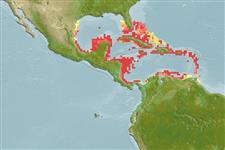Common names from other countries
Environment: milieu / climate zone / depth range / distribution range
Écologie
Récifal; profondeur 0 - 30 m (Ref. 83917). Tropical; 28°N - 9°N, 98°W - 60°W (Ref. 846)
Western Atlantic.
Length at first maturity / Taille / Poids / Âge
Maturity: Lm ? range ? - ? cm
Description synthétique
Morphologie
Species forms the largest colonies of all Acropora, with parallel, obliquely inclined, very thick, tapered branches. Corallites are tubular and irregular in length. Axial corallites are indistinct. Color can either be tan or pale brown with white axial corallites.
Maximum depth from Ref. 116012.
Life cycle and mating behavior
Maturité | Reproduction | Frai | Œufs | Fécondité | Larves
Hermaphroditic (Ref. 113712). Mature gametes are shed into the coelenteron and spawned through the mouth. Life cycle: The zygote develops into a planktonic planula larva. Metamorphosis begins with early morphogenesis of tentacles, septa and pharynx before larval settlement on the aboral end (Ref. 833).
Wallace, C.C. 1999. (Ref. 86439)
Statut dans la liste rouge de l'IUCN (Ref. 130435: Version 2024-1)
statut CITES (Ref. 108899)
Not Evaluated
Utilisations par l'homme
| FishSource |
Outils
Sources Internet
Estimates based on models
Preferred temperature
(Ref.
115969): 26.5 - 28.2, mean 27.5 (based on 464 cells).
Catégorie de prix
Unknown.
